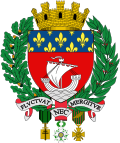This article needs additional citations for verification. (December 2022) |


| History of Paris |
|---|
 |
| See also |
|
|
Paris during the reign of King Louis-Philippe (1830–1848) was the city described in the novels of Honoré de Balzac and Victor Hugo. Its population increased from 785,000 in 1831 to 1,053,000 in 1848, as the city grew to the north and west, while the poorest neighborhoods in the center became even more crowded.[1]
The heart of the city, around the Île de la Cité, was a maze of narrow, winding streets and crumbling buildings from earlier centuries; it was picturesque, but dark, crowded, unhealthy and dangerous. A cholera outbreak in 1832 killed 20,000 people. Claude-Philibert de Rambuteau, prefect of the Seine for fifteen years under Louis-Philippe, made tentative efforts to improve the center of the city: he paved the quays of the Seine with stone paths and planted trees along the river. He built a new street (now the Rue Rambuteau) to connect the Marais district with the markets and began construction of Les Halles, the famous central food market of Paris, finished by Napoleon III.[2]
Louis-Philippe lived in his old family residence, the Palais-Royal, until 1832, before moving to the Tuileries Palace. His chief contribution to the monuments of Paris was the completion in 1836 of the Place de la Concorde, which was further embellished on 25 October 1836 by the placement of the Luxor Obelisk. In the same year, at the other end of the Champs-Élysées, Louis-Philippe completed and dedicated the Arc de Triomphe, which had been begun by Napoleon I.[2]
The ashes of Napoleon were returned to Paris from Saint Helena in a solemn ceremony on 15 December 1840, and Louis-Philippe built an impressive tomb for them at the Invalides. He also placed the statue of Napoleon on top of the column in the Place Vendôme. In 1840, he completed a column in the Place de la Bastille dedicated to the July 1830 revolution which had brought him to power. He also sponsored the restoration of the Paris churches ruined during the French Revolution, a project carried out by the ardent architectural historian Eugène Viollet-le-Duc; the first church slated for restoration was the Abbey of Saint-Germain-des-Prés. Between 1837 and 1841, he built a new Hôtel de Ville with an interior salon decorated by Eugène Delacroix.[3]
The first railway stations in Paris (then called embarcadères) were built under Louis-Philippe. Each belonged to a different company, and they were not connected to each other; all were located outside the city center. The first, the Embarcadère Saint-Germain, was opened on 24 August 1837 on the Place de l'Europe. An early version of the Gare Saint-Lazare was started in 1842, and the first lines from Paris to Orléans and to Rouen were inaugurated on 1–2 May 1843.[4]
As the population of Paris grew, so did discontent in the working-class neighborhoods. There were riots in 1830, 1831, 1832, 1835, 1839, and 1840. The 1832 uprising, which followed the funeral of a fierce critic of Louis-Philippe, General Jean Maximilien Lamarque, was immortalized by Victor Hugo in his novel Les Misérables.[5]
The growing unrest finally exploded on 23 February 1848, when a large demonstration was broken up by the army. Barricades went up in the eastern working-class neighborhoods. The king reviewed his soldiers in front of the Tuileries Palace, but instead of cheering him, many shouted "Long Live Reform!" Discouraged, he abdicated and departed for exile in England.
- ^ Héron de Villefosse 1959, p. 323.
- ^ a b Héron de Villefosse 1959, pp. 323–324.
- ^ Héron de Villefosse 1959, pp. 325–327.
- ^ Héron de Villefosse 1959, pp. 325–331.
- ^ Manéglier, Hervé, Paris impérial, p. 19
